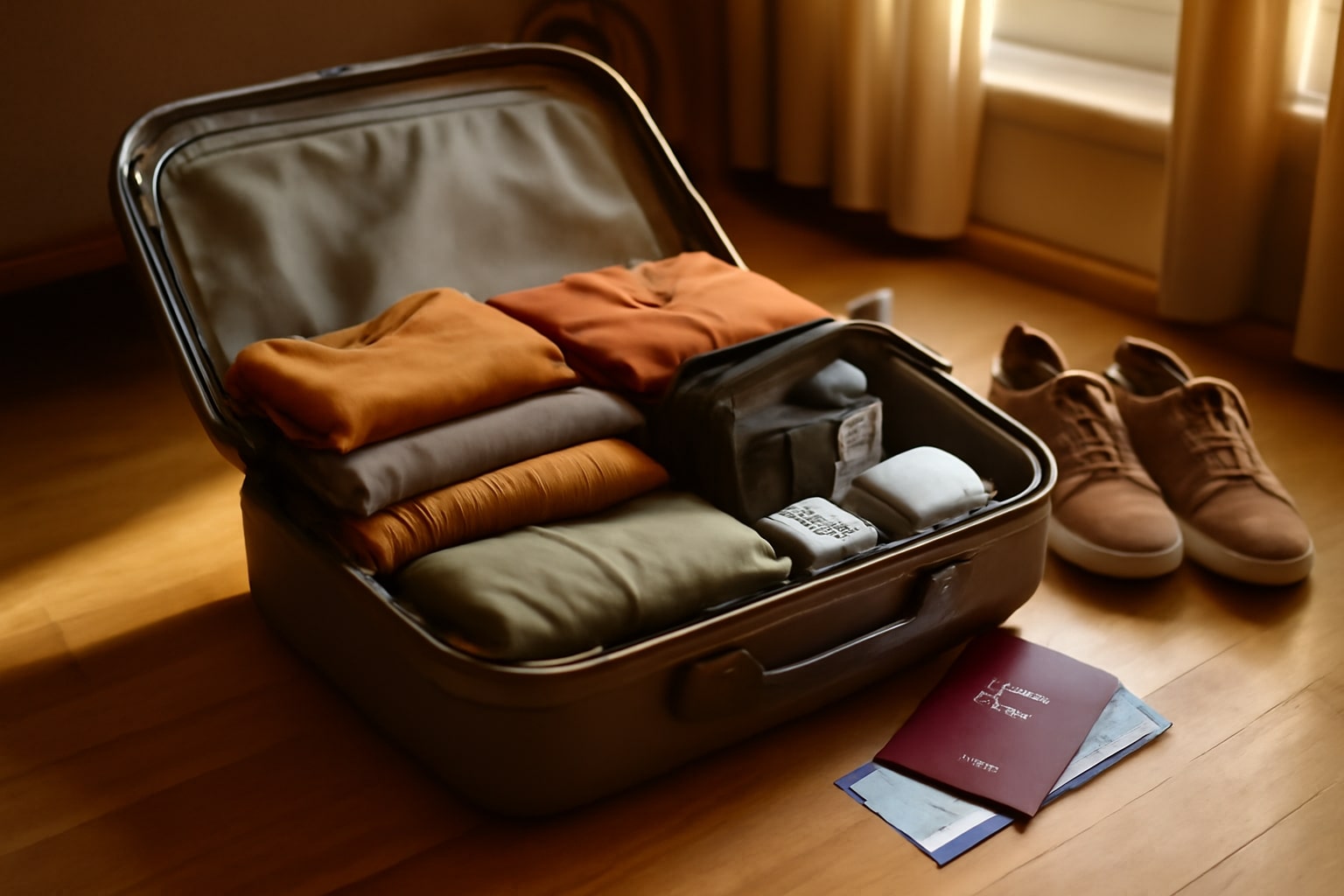The Ultimate Europe Packing List: Travel Smart and Stress-Free
A trip to Europe promises a whirlwind of ancient history, breathtaking landscapes, vibrant cultures, and culinary delights. The excitement of planning your route, booking your stays, and dreaming of cobblestone streets is unparalleled. However, this excitement can quickly turn to anxiety when faced with the daunting question: “What should I pack?” Overpacking can lead to hefty baggage fees and the hassle of lugging a heavy suitcase over uneven terrain, while under-packing might leave you unprepared for unpredictable weather or a special occasion.
This comprehensive guide is designed to eliminate the guesswork and stress from your preparations. We will walk you through every essential category, from documents and clothing to electronics and toiletries, ensuring you have everything you need for a comfortable, safe, and unforgettable European adventure. By focusing on versatility, practicality, and smart packing strategies, you can create a lightweight yet fully-equipped travel wardrobe that prepares you for anything, whether you’re exploring the sunny coasts of Italy or the snowy peaks of Switzerland.
Before You Pack: Essential Pre-Trip Preparations
The first step to smart packing happens before a single item goes into your bag. Your itinerary and the time of year are the two most significant factors that will dictate your packing list. Begin by researching the typical weather conditions for your destinations during your travel dates. A Mediterranean cruise in July requires a vastly different wardrobe than a tour of German Christmas markets in December. Consider the types of activities you have planned—will you be hiking in the Scottish Highlands, dining at a chic Parisian restaurant, or spending your days exploring museums? A clear understanding of your plans will help you choose practical and appropriate items.
Choosing the right luggage is just as critical as choosing what to put inside it. For Europe, the debate between a suitcase and a backpack is a classic one. A rolling suitcase offers easy organization and is great for travelers staying in one or two locations with smooth pavements. However, navigating ancient cobblestone streets, narrow staircases in old hotels, and crowded public transport can be challenging with a wheeled bag. A travel backpack, on the other hand, offers superior mobility and is the preferred choice for those hopping between multiple cities, using budget airlines with strict carry-on rules, or planning more adventurous excursions.
Indispensable Documents and Money
Your travel documents are the single most important items you will pack, so double-check everything before you leave. Ensure your passport is valid for at least six months beyond your planned date of departure from Europe, as this is a requirement for many countries. Check the visa requirements for your nationality; while many travelers can enter the Schengen Area visa-free for up to 90 days, others may need to apply in advance. It is highly advisable to make both physical photocopies and digital copies of your passport, visas, driver’s license, and travel insurance details. Store these copies separately from the originals.
When it comes to money, a multi-pronged approach is best. While the Euro is the official currency in 20 of the 27 EU member states, several European countries, such as the United Kingdom, Switzerland, and the Czech Republic, use their own currencies. Inform your bank of your travel dates to avoid your cards being frozen for suspicious activity. Use a credit or debit card that offers no foreign transaction fees for the best exchange rates on purchases and ATM withdrawals. It’s also wise to carry a small amount of local currency in cash for immediate expenses upon arrival, like a taxi or a coffee, and for use at smaller shops or markets that may not accept cards.
Clothing: The Art of Layering for Europe’s Ever-Changing Weather
The secret to a successful European travel wardrobe is mastering the art of layering. Weather across the continent can be notoriously fickle, with sunny mornings often giving way to rainy afternoons or chilly evenings, especially in the spring and autumn. Packing in layers allows you to adapt to changing temperatures throughout the day without needing a vast collection of different outfits. Start with a foundation of neutral-colored base layers, such as t-shirts, tank tops, and long-sleeved shirts, that can be easily mixed and matched.
On top of your base layers, add versatile mid-layers like a cozy cardigan, a classic sweater, or a lightweight fleece jacket. These pieces provide warmth and can be easily removed and stored in a daypack if the sun comes out. For bottoms, pack two to three versatile pairs of pants. Dark-wash jeans, comfortable chinos, or tailored trousers are excellent options that can be dressed down for daytime sightseeing or dressed up for an evening out. Finally, a high-quality, waterproof and windproof jacket is arguably the most important piece of clothing you can bring, regardless of the season.
Packing for a European Summer (June-August)
Summer in Europe calls for lightweight and breathable fabrics that will keep you cool and comfortable during long days of exploration. Materials like cotton, linen, and moisture-wicking synthetics are your best friends. Pack a selection of shorts, t-shirts, and sundresses for daytime wear. While your instinct might be to pack for heat, remember that many churches and religious sites have modest dress codes, requiring shoulders and knees to be covered, so a lightweight scarf or a pair of linen trousers can be invaluable.
While sunshine is the goal, sun protection is a necessity. The summer sun can be intense, especially in southern Europe, so a high-SPF sunscreen for your face and body is non-negotiable. Augment this with a stylish wide-brimmed hat to protect your face and neck, and a pair of UV-blocking sunglasses. Even during the hottest months, evenings can become cool, particularly in coastal or northern regions, so always pack a light jacket, cardigan, or pashmina for an extra layer of warmth after the sun goes down.
Packing for a European Winter (December-February)
Packing for a European winter is all about staying warm and dry. The key to comfort in cold weather is a solid base layer of thermal underwear. Long-sleeved thermal tops and leggings made from merino wool or a high-tech synthetic fabric will trap your body heat and wick away moisture, keeping you warm without feeling bulky. Your choice of socks is equally important; pack several pairs of thick wool socks to keep your feet toasty and prevent blisters during long walks in the cold.
Your outerwear is your primary shield against the elements. A well-insulated, waterproof winter coat that covers your hips is essential. Look for features like a hood, sealed seams, and wind-resistant fabric. Don’t forget your winter accessories, as they make a significant difference in your overall warmth and comfort. A soft scarf, a warm hat or beanie that covers your ears, and a pair of waterproof gloves are absolute must-haves for braving the chilly winds and potential snowfall of a European winter.
The Right Footwear for Miles of Walking
You will walk more than you can possibly imagine in Europe. From sprawling museum corridors and vast palace gardens to charming, hilly villages and endless city blocks, your feet will carry you everywhere. This makes comfortable footwear the most critical item on your packing list. Your primary pair of shoes should be a stylish yet supremely comfortable pair of sneakers or walking shoes that are already well broken-in. Never bring brand-new shoes on a trip like this; you want something you know you can wear for hours on end without pain.
While one great pair of walking shoes is essential, it’s wise to bring at least one other pair to give your feet a break and to suit different occasions. For summer trips, a pair of supportive sandals can be a great second option. For winter or rainy destinations, a pair of waterproof boots with good traction is non-negotiable for keeping your feet warm and dry. If you plan on enjoying the nightlife or fine dining, a pair of packable, comfortable dress shoes, such as leather loafers or elegant flats, will ensure you look the part without sacrificing comfort. Limit yourself to a maximum of three pairs to save space and weight.
Electronics and Gadgets for the Modern Traveler
In today’s connected world, a few key electronics can make your European journey significantly smoother. The single most essential gadget is a universal travel adapter. Europe has several different plug types (Type C and Type F are the most common), so an all-in-one adapter will ensure you can charge your devices no matter where you go. A close second is a portable power bank. Using your phone for navigation, photos, and translations will drain your battery quickly, and a power bank allows you to recharge on the go without being tethered to a wall outlet.
Beyond power, consider your other tech needs. Your smartphone will likely be your all-in-one camera, map, and communication device. For avid photographers, a dedicated camera might be worth the extra space. An e-reader is a fantastic, lightweight alternative to carrying heavy books for entertainment on long train rides or flights. Don’t forget to pack all the necessary charging cables for your devices, and consider bringing a pair of noise-canceling headphones to make your travel time more peaceful and enjoyable.
Toiletries and Medications: Staying Healthy and Fresh
When it comes to toiletries, think small and solid. To save space and comply with airline liquid restrictions for carry-on luggage, decant your favorite shampoo, conditioner, and lotion into travel-sized (under 100ml or 3.4oz) reusable bottles. Better yet, explore the world of solid toiletries. Shampoo bars, conditioner bars, and solid perfumes are fantastic, eco-friendly alternatives that save space and eliminate the risk of spills in your luggage. Pack your essentials: a toothbrush, toothpaste, deodorant, and any skincare items you can’t live without.
Your health is paramount while traveling, so a small, well-stocked first-aid kit is a must. Include basics like pain relievers (ibuprofen or paracetamol), assorted bandages, antiseptic wipes, blister treatment, and any personal allergy or motion sickness medication. If you take any prescription medications, pack enough for your entire trip in their original packaging, along with a copy of your prescription or a note from your doctor. Hand sanitizer and sanitizing wipes are also invaluable for staying healthy on public transport and before meals.
Miscellaneous Must-Haves and Smart Extras
A few small, miscellaneous items can dramatically improve the quality and convenience of your trip. A reusable water bottle is a top recommendation; it’s environmentally friendly and will save you a significant amount of money, as tap water is safe to drink in most of Europe and public drinking fountains are common. A foldable tote bag or a small, packable daypack is essential for carrying your daily necessities—like your water bottle, camera, and an extra layer—while leaving your main luggage at your accommodation.
To enhance your comfort and security, consider packing a few smart extras. A travel lock provides peace of mind when securing your bags in hostels or on trains. An eye mask and a good pair of earplugs are lifesavers for light sleepers, helping you get quality rest on overnight flights or in noisy city-center hotels. Finally, a travel journal and a pen offer a wonderful way to record your memories, while a good book or downloaded podcasts can provide welcome entertainment during inevitable downtime. These little things often make the biggest difference in your overall travel experience.



